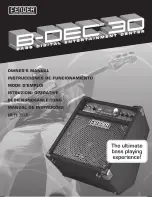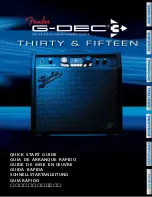
Version 1.32
6
After installation, check the instructions again:
Once a part is installed, double-
check the installation against the printed instructions.
Audio PCB Assembly Instructions:
We assume that you will configure your kit in PP mode, the following instructions are
to do that .
On the main PCB mount resistors R6, R7, R8, R29, R18, R30, and R31
approximately 7mm above the board (these use the Blue PTFE sleeves to mount them
off the board as they run warm in use), as well as (R52 for PSE mode) if you are
configuring the amplifier for PSE mode. Resistors R6 & R7, and R8 & R29 should
also be separated apart from each other by approximately 7mm. If the volume pot is
being used then leave out resistor R1. Resistor R17 must be mounted on the reverse
side (track side) of the board by approximately 5mm, although it is a good idea to fit
this when the small valve bases are soldered in place.
There are two positions for resistor R11, either R11 or R11b, depending on whether
the amplifier is to be used in PP or PSE mode. To make it easier to change between
either mode do not put the 1K resistor in R11b, but stand it up so that one leg of the
resistor goes to the top of C2, (the output from the signal capacitor) and the other goes
to the track that links to point X13. (Same track as the top of R11B) Resistor R11
should be put in as well. If this is done the PCB will be set up for both PP and PSE,
and will not need to be changed. Now go through the parts list and solder in the
remaining resistors and capacitors. Note: when placing the electrolytic capacitors be
sure to insert them paying attention to polarity. The signal capacitors C1, C2, C10,
and C13 are not polarized, but will become so in use. As a rule of thumb, if you are
using the supplied SCR caps, with the writing toward you take the left hand side as
going towards the valve and the right hand side as the output. This does sound slightly
better, but don't worry if you get them around the other way as being of
polypropylene construction they will soon polarize in either way around. Bend
resistors R30 and R31 away from capacitors C3 and C4, as the resistors may warm up
after prolonged use.
Strip a length of any of the thin coloured wire supplied, (we recommend black) and
link points P1 through to P10 (fit links between points), although P10 must be
connected on one board only as connecting both will result in a ground loop.
Solder the terminal pins in holes X1 to X13. The PCB’s have holes for two different
types of valve base, so the small valve bases V3 and V4 must be soldered in the
opposite side of the board from the components
, in the larger holes. It is quite
important to keep them square (parallel) to the circuit board when soldering so that
they align into the front chassis panel properly. Take time and care when fitting these.
See picture below for an idea of how the finished board should look.







































